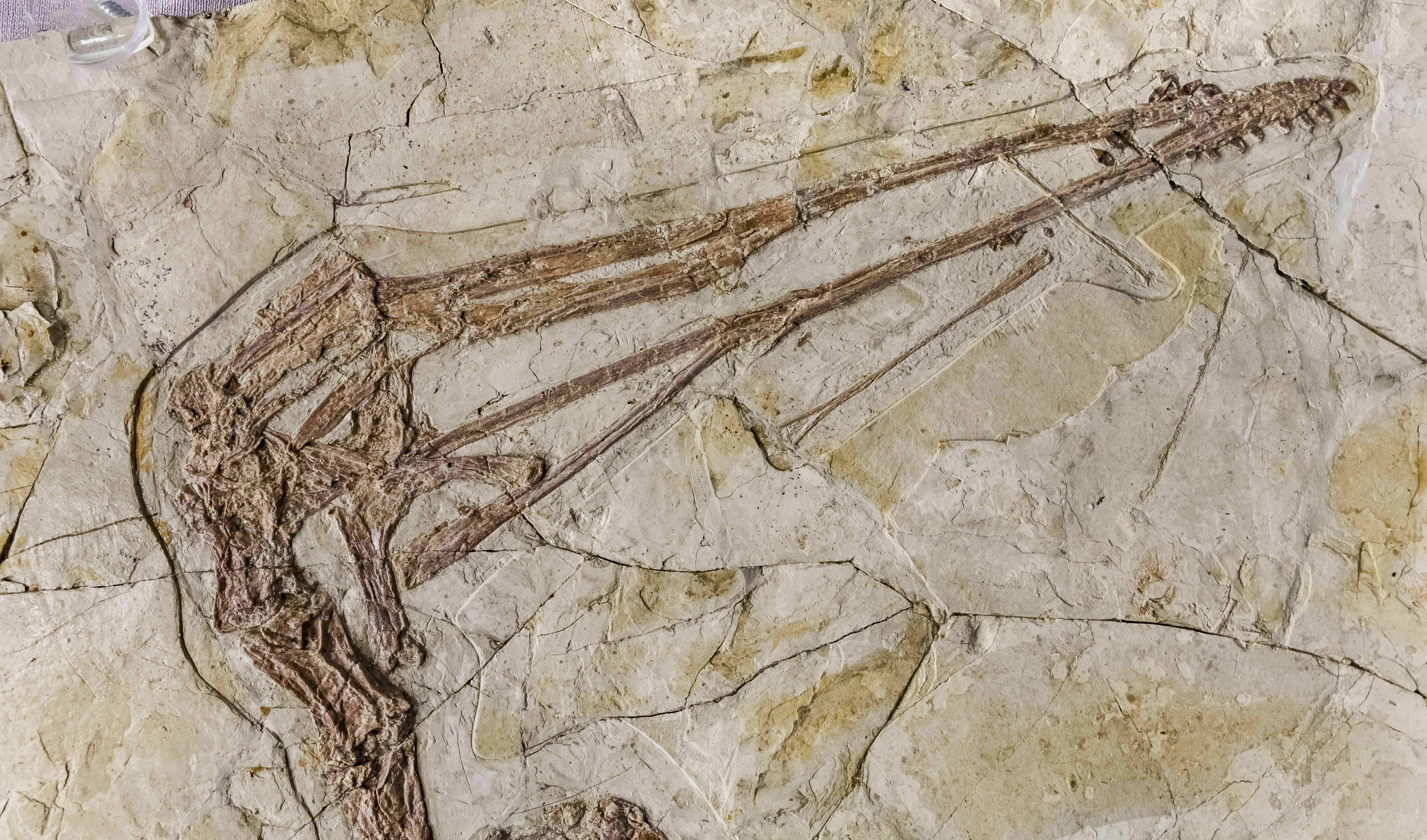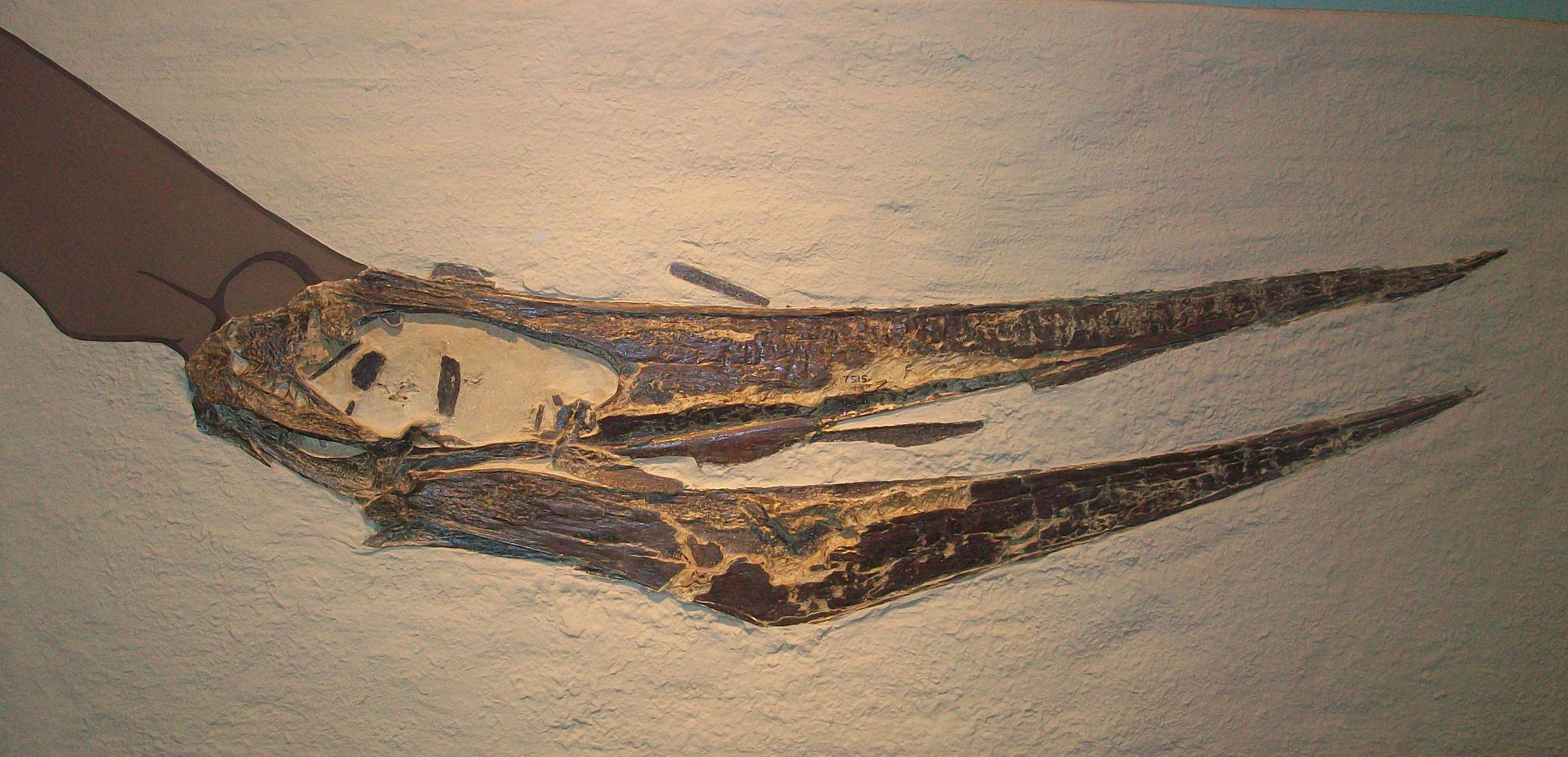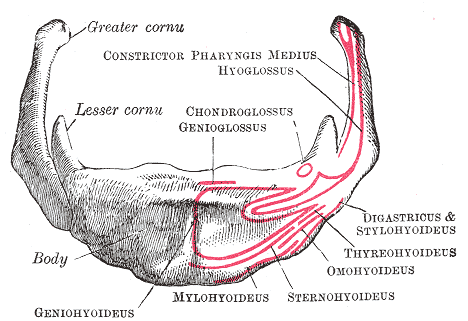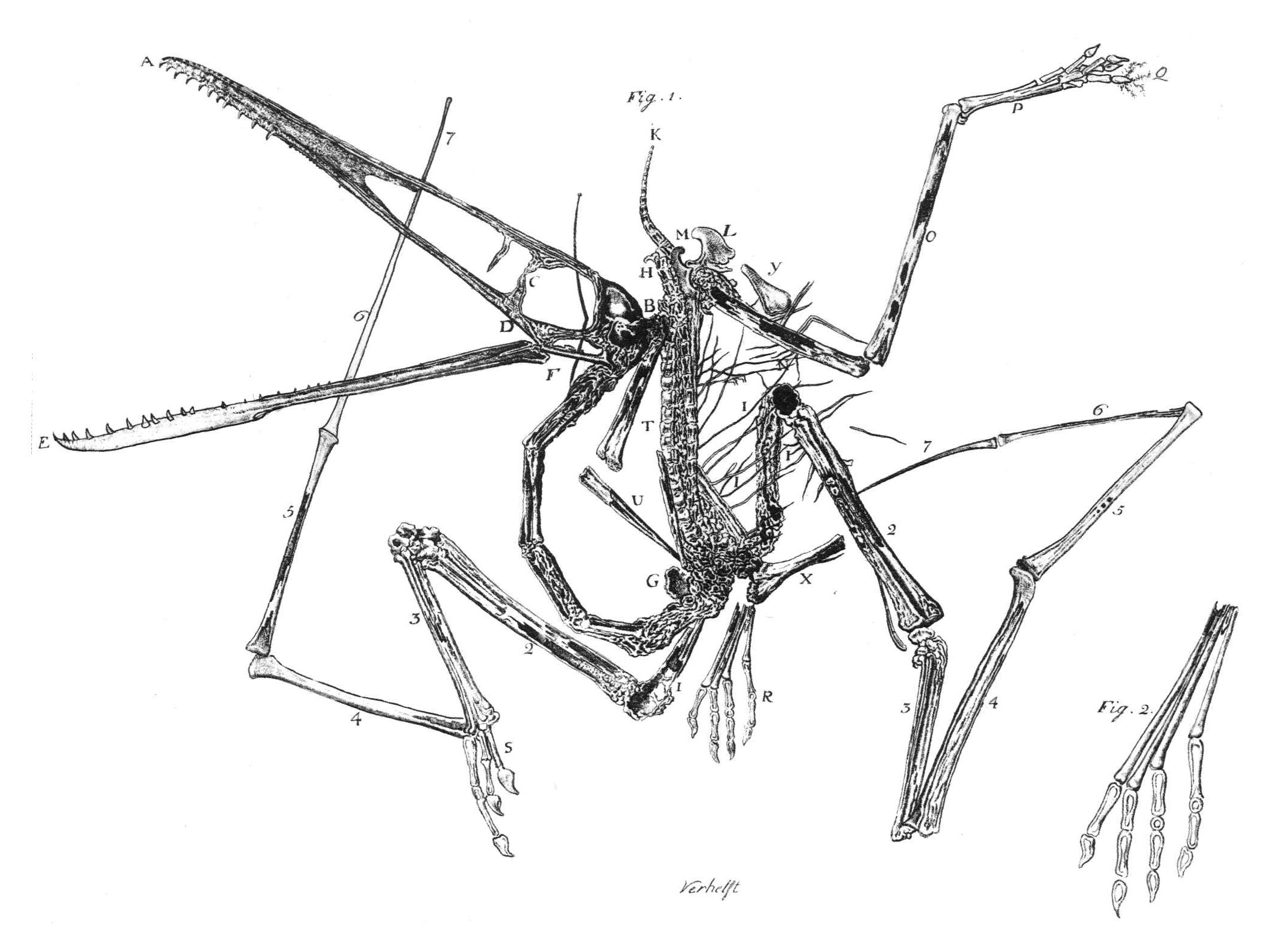|
Liaoxipterus
''Liaoxipterus'' is a genus of pterodactyloid pterosaur from the Barremian-Aptian-age Lower Cretaceous Jiufotang Formation of Chaoyang, Liaoning, China. The type species is ''Liaoxipterus brachyognathus''. The genus name is derived from the discovery locality Liaoxi and a Latinised Greek ''pteron'', "wing". The specific name is derived from Greek ''brachys'', "short" and ''gnathos'', "jaw". Description The genus is based on holotype CAR-0018, an almost complete but crushed 161 millimetres long mandible (fused lower jaws), which differs from that of all known other ctenochasmatids in its short teeth and low tooth count (eleven per side). Also a detached hyoid is present.Dong, Z., and Lü, J. (2005). A New Ctenochasmatid Pterosaur from the Early Cretaceous of Liaoning Province. ''Acta Geologica Sinica'' 79(2):164-167. The jaw of ''Liaoxipterus'' had a rounded top filled with small, peg-like teeth. The shape of the teeth, and the anatomy of the ''hyoid'' (a bone that anchors the ... [...More Info...] [...Related Items...] OR: [Wikipedia] [Google] [Baidu] |
Istiodactylidae
Istiodactylidae is a small family of pterosaurs. This family was named in 2001 after the type genus ''Istiodactylus'' was discovered not to be a member of the genus ''Ornithodesmus''. Systematics and distribution Remains of taxa that can be confidently assigned to Istiodactylidae have been found in the UK and China, in rocks dating from the Early Cretaceous period (Barremian to Aptian stage). Arbour and Currie (2011) described Canadian '' Gwawinapterus beardi'' as a member of Istiodactylidae living in the late Cretaceous (upper Campanian stage); however, Witton (2012) suggested the tooth replacement pattern in this animal does not match that of pterosaurs, suggesting that the species might be non-pterosaurian. Additional research suggested that the species was in fact a fish. The earliest known species might be ''Archaeoistiodactylus linglongtaensis'', from the Middle Jurassic of China; however, it also has been suggested that the holotype specimen of this species might actuall ... [...More Info...] [...Related Items...] OR: [Wikipedia] [Google] [Baidu] |
Nurhachius
''Nurhachius'' is a genus of istiodactylid pterodactyloid pterosaur from the Barremian to Aptian-age Lower Cretaceous Jiufotang Formation of Chaoyang, Liaoning, China. Its fossil remains date back about 120 million years ago. Discovery The genus was named in 2005 by Wang Xiaolin, Alexander Kellner, Zhou Zhonghe and Diogenes de Almeida Campos. The type species is ''Nurhachius ignaciobritoi''. The genus name refers to Nurhaci, the first emperor of the Qing Dynasty, whose original power base encompassed the region where the fossil was found. The specific name honors the late Brazilian paleontologist Ignácio Aureliano Machado Brito, who pioneered the study of pterosaurs in his country. ''Nurhachius'' was first described based on its holotype fossil, IVPP V-13288, a partial skull and skeleton. A second specimen, IVPP V-13288, was later referred to the species. In 2019, a second species was named: ''Nurhachius luei''. The specific name honors the late Lü Junchang. It is base ... [...More Info...] [...Related Items...] OR: [Wikipedia] [Google] [Baidu] |
Hongshanopterus Lacustris
''Hongshanopterus'' is a genus of pterodactyloid pterosaur from the Lower Cretaceous Jiufotang Formation of Liaoning, China. The type species ''Hongshanopterus lacustris'' was in 2008 named and described by Wang Xiaolin, Diogenes de Almeida Campos, Zhou Zhonghe and Alexander Wilhelm Armin Kellner. The generic name combines a reference to the Hongshan culture in Lioaning with a Latinised Greek ''pteron'', "wing". The specific name means "of the lake" in Latin, referring to the lake deposits the fossil was found in, at Dapinfang. ''Hongshanopterus'' is based on the holotype IVPP V14582, found in a layer of the Jiufotang Formation dating from the Aptian, It consists of a skull and five neck vertebrae of a single subadult individual. The wingspan of ''Hongshanopterus'' was estimated at 1.8 to 1.9 meters. It possessed a relatively high number of teeth, about thirty-six for both upper jaws combined. The teeth were robust and had triangular crowns which were flattened from mout ... [...More Info...] [...Related Items...] OR: [Wikipedia] [Google] [Baidu] |
Pteranodon Longiceps
''Pteranodon'' (); from Ancient Greek (''pteron'', "wing") and (''anodon'', "toothless") is a genus of pterosaur that included some of the largest known flying reptiles, with ''P. longiceps'' having a wingspan of . They lived during the late Cretaceous geological period of North America in present-day Kansas, Nebraska, Wyoming, South Dakota and Alabama. More fossil specimens of ''Pteranodon'' have been found than any other pterosaur, with about 1,200 specimens known to science, many of them well preserved with nearly complete skulls and articulated skeletons. It was an important part of the animal community in the Western Interior Seaway. ''Pteranodon'' was not a dinosaur. By definition, all dinosaurs belong to the group Dinosauria; ''Pteranodon'' belongs to the group Pterosauria. Nonetheless, ''Pteranodon'' is the most famous pterosaur, frequently featured in dinosaur media and strongly associated with dinosaurs by the general public. While not dinosaurs, pterosaurs such as ' ... [...More Info...] [...Related Items...] OR: [Wikipedia] [Google] [Baidu] |
Jiufotang Formation
The Jiufotang Formation (Chinese: 九佛堂组, pinyin: ''jiǔfótáng zǔ'') is an Early Cretaceous geological formation in Chaoyang, Liaoning which has yielded fossils of feathered dinosaurs, primitive birds, pterosaurs, and other organisms (see Jehol Biota). It is a member of the Jehol group. The exact age of the Jiufotang has been debated for years, with estimates ranging from the Late Jurassic to the Early Cretaceous. New uranium-lead dates reveal the formation is deposited in the Aptian stage of the Early Cretaceous. Fossils of ''Microraptor'' and ''Jeholornis'' are from the Jiufotang. Fossil content Choristoderans Fish Mammaliamorphs Several mammaliamorph specimens have been found from the Jiufotang, but only two have been formally described and named. Ornithischians Pterosaurs Saurischians A large titanosaur is present in the formation. Enantiornithines Euornithines Misc theropods See also * Yixian Formation * List of dinosaur-bearing rock for ... [...More Info...] [...Related Items...] OR: [Wikipedia] [Google] [Baidu] |
Chaoyang, Liaoning
Chaoyang () is a prefecture-level city in western Liaoning province, People's Republic of China. With a vast land area of almost , it is by area the largest prefecture-level city in Liaoning, and borders on Hebei province and the Inner Mongolia Autonomous Region to the west. The area under Chaoyang's jurisdictional control is split up into two counties (Jianping, Chaoyang), two urban districts (Longcheng, Shuangta), two county-level cities (Beipiao, Lingyuan), and the Harqin Left Wing Mongolian Autonomous County. The total regional population is 3 million, while the urban centre where the government office is located has a population of 430,000 and forms the core of Chaoyang. Known as China's 'fossil city', many important paleontological discoveries have been made in Chaoyang, and the Harqin region is the oldest currently known prehistoric site in northern China. Two of the most remarkable Early Cretaceous birds known to date were recovered in the vicinity of the Jiufotang Form ... [...More Info...] [...Related Items...] OR: [Wikipedia] [Google] [Baidu] |
Hyoid
The hyoid bone (lingual bone or tongue-bone) () is a horseshoe-shaped bone situated in the anterior midline of the neck between the chin and the thyroid cartilage. At rest, it lies between the base of the mandible and the third cervical vertebra. Unlike other bones, the hyoid is only distantly articulated to other bones by muscles or ligaments. It is the only bone in the human body that is not connected to any other bones nearby. The hyoid is anchored by muscles from the anterior, posterior and inferior directions, and aids in tongue movement and swallowing. The hyoid bone provides attachment to the muscles of the floor of the mouth and the tongue above, the larynx below, and the epiglottis and pharynx behind. Its name is derived . Structure The hyoid bone is classed as an irregular bone and consists of a central part called the body, and two pairs of horns, the greater and lesser horns. Body The body of the hyoid bone is the central part of the hyoid bone. *At the front, ... [...More Info...] [...Related Items...] OR: [Wikipedia] [Google] [Baidu] |
Coloborhynchus Spielbergi
''Maaradactylus'' is a genus of anhanguerid pterodactyloid pterosaur known from the Lower Cretaceous period (Aptian to Albian stages) of the Romualdo Formation of northeastern Brazil. Discovery ''Maaradactylus'' is based on the Museu Paleontologico de Santana do Cariri specimen MPSC R 2357, a skull, atlas, and axis discovered in 2010 in the Aptian— Albian-age Romualdo Formation of Sítio São Gonçalo, Santana do Cariri, Ceará, in the Araripe Basin of Brazil. ''Maaradactylus'' was described by Renan Bantim and colleagues in 2014. The type species is ''Maaradactylus kellneri''. The generic name refers to Maara, in the legends of the Cariri the daughter of a chief, by sorcery changed into a river monster with long teeth, devouring fishermen. The suffix ~''dactylus'' is common in the names of pterosaurs and is derived from Greek δάκτυλος, ''daktylos'', "finger", referring to the long (fourth) wing finger. The specific name honors Alexander Kellner, Brazi ... [...More Info...] [...Related Items...] OR: [Wikipedia] [Google] [Baidu] |
Pterodactylus Antiquus
''Pterodactylus'' (from Greek () meaning 'winged finger') is an extinct genus of pterosaurs. It is thought to contain only a single species, ''Pterodactylus antiquus'', which was the first pterosaur to be named and identified as a flying reptile. Fossil remains of ''Pterodactylus'' have primarily been found in the Solnhofen limestone of Bavaria, Germany, which dates from the Late Jurassic period (early Tithonian stage), about 150.8 to 148.5 million years ago. More fragmentary remains of ''Pterodactylus'' have tentatively been identified from elsewhere in Europe and in Africa. ''Pterodactylus'' was a generalist carnivore that probably fed on a variety of invertebrates and vertebrates. Like all pterosaurs, ''Pterodactylus'' had wings formed by a skin and muscle membrane stretching from its elongated fourth finger to its hind limbs. It was supported internally by collagen fibres and externally by keratinous ridges. ''Pterodactylus'' was a small pterosaur compared to other famou ... [...More Info...] [...Related Items...] OR: [Wikipedia] [Google] [Baidu] |
Outgroup (cladistics)
In cladistics or phylogenetics, an outgroup is a more distantly related group of organisms that serves as a reference group when determining the evolutionary relationships of the ingroup, the set of organisms under study, and is distinct from sociological outgroups. The outgroup is used as a point of comparison for the ingroup and specifically allows for the phylogeny to be rooted. Because the polarity (direction) of character change can be determined only on a rooted phylogeny, the choice of outgroup is essential for understanding the evolution of traits along a phylogeny. History Although the concept of outgroups has been in use from the earliest days of cladistics, the term "outgroup" is thought to have been coined in the early 1970s at the American Museum of Natural History. Prior to the advent of the term, various other terms were used by evolutionary biologists, including "exgroup", "related group", and "outside groups". Choice of outgroup The chosen outgroup is hypothes ... [...More Info...] [...Related Items...] OR: [Wikipedia] [Google] [Baidu] |
Taxa
In biology, a taxon (back-formation from ''taxonomy''; plural taxa) is a group of one or more populations of an organism or organisms seen by taxonomists to form a unit. Although neither is required, a taxon is usually known by a particular name and given a particular ranking, especially if and when it is accepted or becomes established. It is very common, however, for taxonomists to remain at odds over what belongs to a taxon and the criteria used for inclusion. If a taxon is given a formal scientific name, its use is then governed by one of the nomenclature codes specifying which scientific name is correct for a particular grouping. Initial attempts at classifying and ordering organisms (plants and animals) were set forth in Carl Linnaeus's system in ''Systema Naturae'', 10th edition (1758), as well as an unpublished work by Bernard and Antoine Laurent de Jussieu. The idea of a unit-based system of biological classification was first made widely available in 1805 in the int ... [...More Info...] [...Related Items...] OR: [Wikipedia] [Google] [Baidu] |
Cladogram
A cladogram (from Greek ''clados'' "branch" and ''gramma'' "character") is a diagram used in cladistics to show relations among organisms. A cladogram is not, however, an evolutionary tree because it does not show how ancestors are related to descendants, nor does it show how much they have changed, so many differing evolutionary trees can be consistent with the same cladogram. A cladogram uses lines that branch off in different directions ending at a clade, a group of organisms with a last common ancestor. There are many shapes of cladograms but they all have lines that branch off from other lines. The lines can be traced back to where they branch off. These branching off points represent a hypothetical ancestor (not an actual entity) which can be inferred to exhibit the traits shared among the terminal taxa above it. This hypothetical ancestor might then provide clues about the order of evolution of various features, adaptation, and other evolutionary narratives about ance ... [...More Info...] [...Related Items...] OR: [Wikipedia] [Google] [Baidu] |









